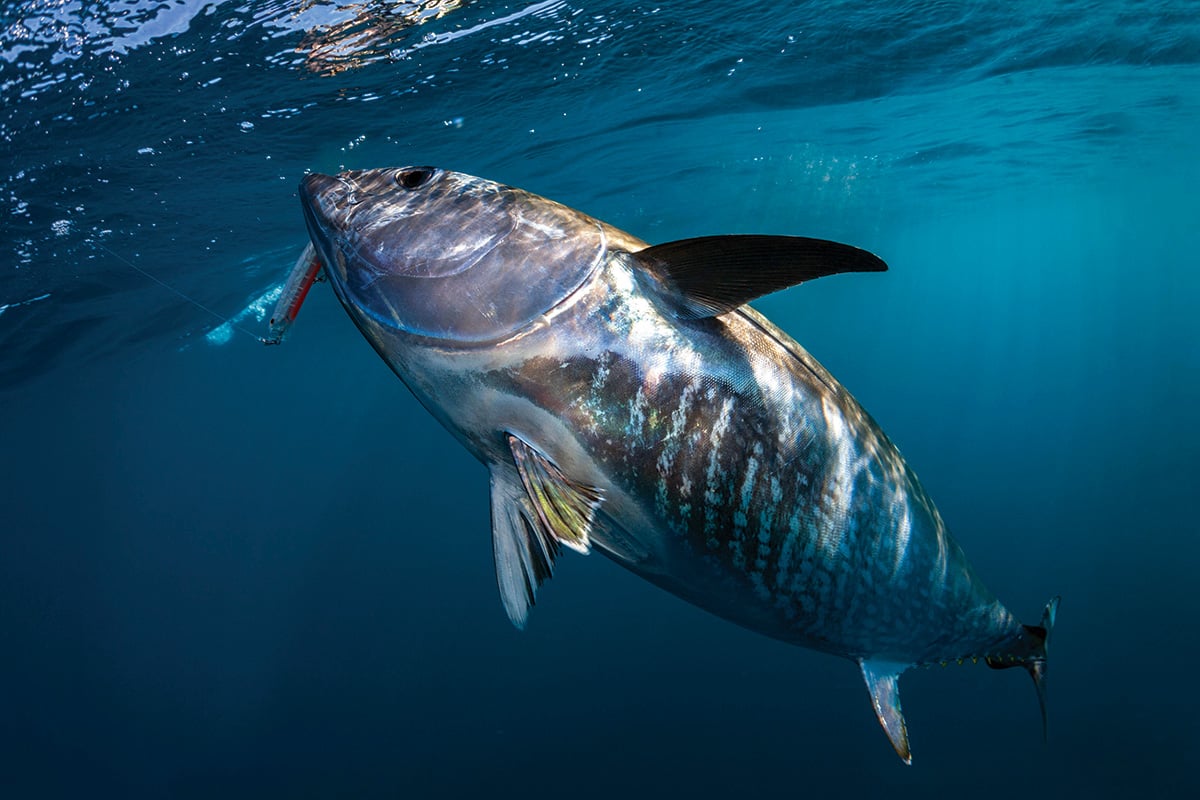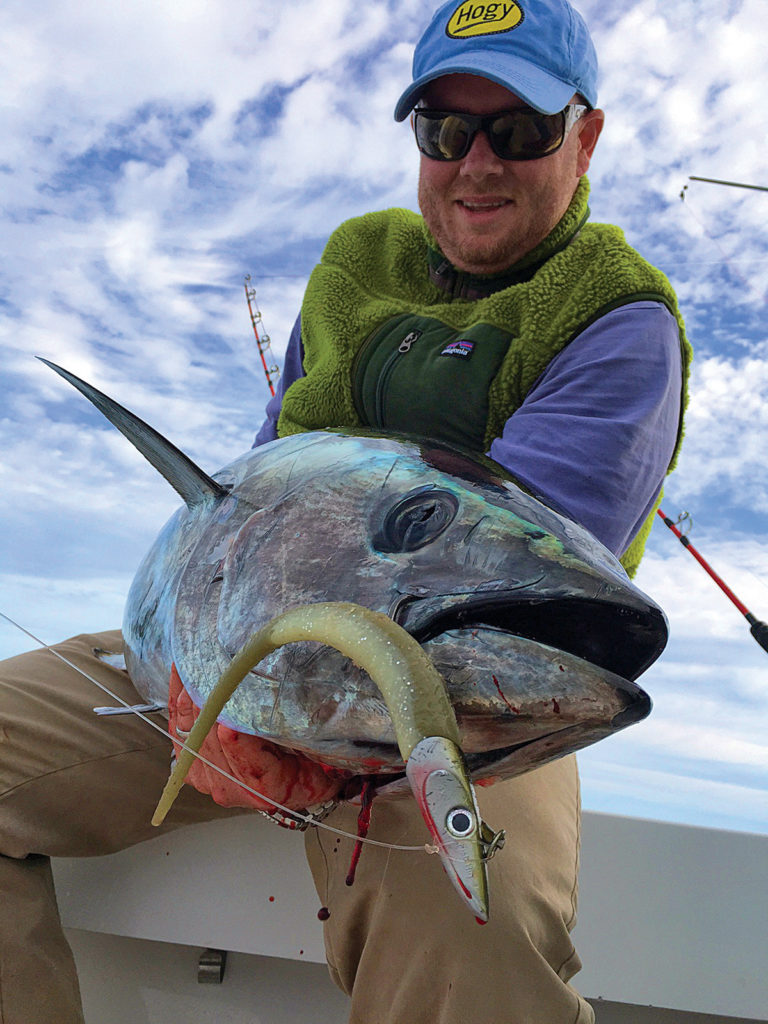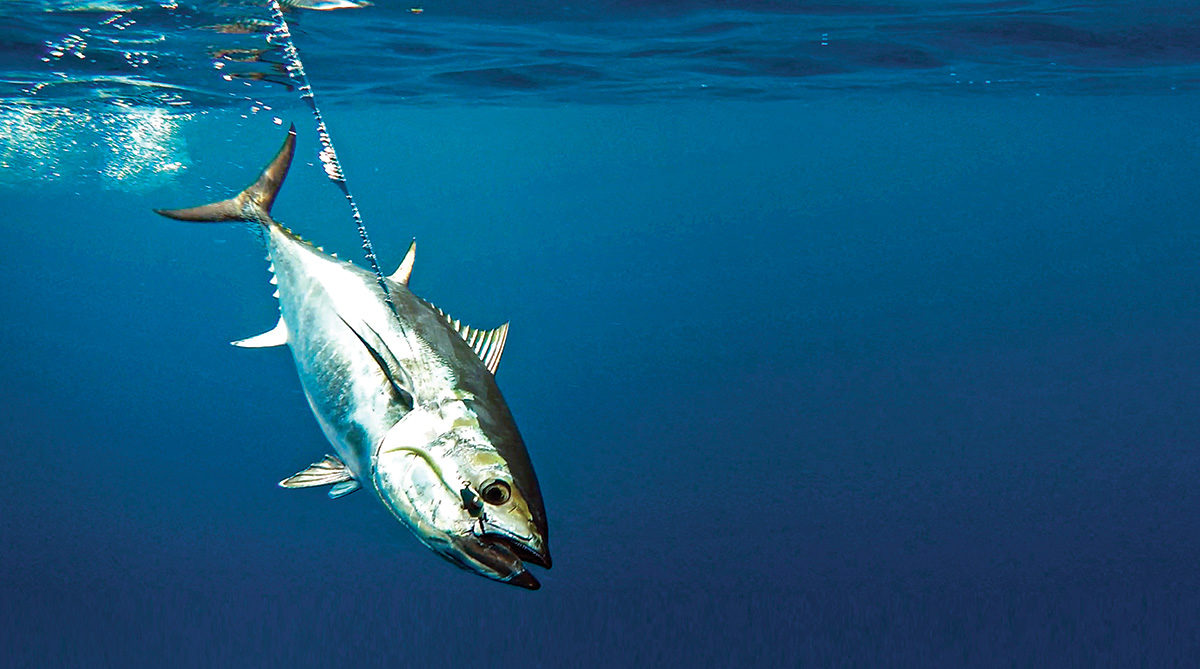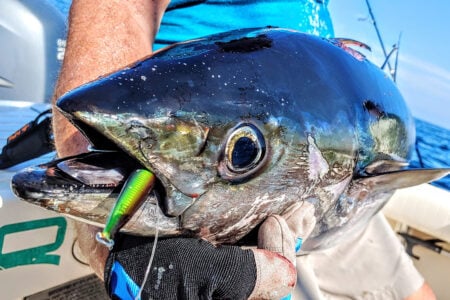
A few years back during the first week of November, I dropped my lines and pointed my boat south to head to the Dip for a late season shot at tuna. Approximately an hour into the trip, Greg DeSantis on the Barbaric contacted me on the radio. All he said was “get to the 100 Square now!” It was a good thing that I listened to him. That day turned into my most memorable trip as we were hooked up with 150- to 200-pound bluefin all day. We fought one fish at a time and it took us less than five minutes to hook up with the next fish using whole sardine hook baits. At that time of the year many boats have left for southern ports or have already been pulled and are starting the winterization process. There are a handful of savvy, hard core fishermen from New England down to New Jersey that consider this the middle of the fall run. They fish right through November into December with great success, thanks largely to the abundance of bait in our offshore waters. Last season saw several New Jersey and Long Island boats catching tuna right up until the week before Christmas.
Most anglers that are still fishing in November and December are focusing on striped bass, with many of them unaware of the potential to tangle with tuna, especially bluefins, this late in the season. Some years, action can be found as close as the 20 fathom line, while other years might require running to the canyons. Water clarity and temperature are still key components for finding these fish, since once temperatures dip below 60 degrees it is pretty much over.
Capt. Frank Wagenhoffer and Frank Crescitelli run the charter boat www.FinChaser.com out of New Jersey. They fish mostly out of Manasquan Inlet and Long Beach Island, but they try to move to marinas closest to where they can find the fish to minimize running time and maximize fishing time. Captain Frank has caught large bluefins right up to the third week of December. Depending on their migratory pattern, the furthest he will normally run is the ResorWreck. For the most part this fishery off the Jersey Coast takes place on popular sharking grounds like The Slue, Little Italy, Mud Hole, Middle Grounds, and Monster Ledge.

Capt. Patrick Sciacca, who fishes out of Long Island’s South Shore, said the late fishing can involve a lot of running and looking until you find the fish, which at this time of the year are almost always on the move. You might find them at the 100 Square, the next trip might be the Texas Tower or the Bacardi wreck. Last year, he and his buddies got into some wild jigging action at the Hudson well into December. He pointed out that this fishery is not for everyone. Late fall bluefin are on the move,and the action can be very hit or miss. You also need the right boat for the job. It can be cold, and the weather can turn ugly quickly this time of the year. There is a particular art to forcing these migration minded fish to change their agenda and turn on the feeding bag. Be prepared to have days where you mark and visually see fish that will never take a bait, but being persistent usually pays off.
Up north off the Massachusetts Coast, if the season is still open for giants (The bluefin fishery is closely regulated and subject to closures.) Cape Cod Bay, the southwest corner of Stellwagen and the waters off the tip of Race Point have been consistent producers of big fish the past few years. For smaller, school-size fish, the backside of the Cape from about the Golf Balls to Chatham has been good late into the season. East of Chatham, the Regal Sword and Crab Ledge have been known to hold fish through November.
Captain Frank will not even bother putting a bait in the water until he has found what he deems a fishy spot. It sounds simple, but from New England to New Jersey and even the Outer Banks,the best captains hunt for their prey and won’t fish for them until they are located. This starts by poring over temperature and chlorophyll charts before you even leave the dock. Search for breaks you saw on the charts, and know what direction they may be moving. Work your sources for intel and leads on the general area the fish may be in. As you run your boat everyone must be on the lookout for the typical signs of life – whales, birds, busting fish or bait being pushed up to the surface. Sometimes it’s not a lot of birds but just a few diving birds that are working where tuna are. Always check out the area, regardless of the number of birds. Use your electronics – radar to find birds, and your fishfinder to locate marks. Once you have located these signs, it’s time to start fishing.
If you are marking fish down deep, jigging is a great way to get down to entice a strike. New Englanders are big on soft plastics like Ron Zs and Hogy leadheads. They imitate sand eels and are killer throughout the water column. Further south and through New Jersey, Butterfly and West Coast style metal jigs see a lot of use. And don’t overlook poppers. When fish are on the surface, a well-placed popper may be just the ticket to turn a tuna’s head. If you haven’t experienced the explosive surface strike of a tuna, there is nothing quite like it.
When some skippers locate fish and they are in the middle of the water column, they will turn to chunking. The Fin Chaser crew will use Kettle Creek paddle tail leadheads to catch chicsize mahimahi. These are then live-lined along with standard chunk baits like sardines, butterfish and squid. Capt. Frank has a unique way of pinning the live baits’ mouths closed, which makes the bait less hardy, but will result in a less active bait that tends to stay inside the chunk zone. The idea is to use this more as live chum to help attract bluefin to one of their chunk baits. The only set back to this method is they need to be changed out fairly frequently.

When it comes to doling out chunks most boats rely on butterfish and sardines. The boats to the north will stay away from some of the more oily chunks like mackerel and bluefish so as not to attract blue sharks. No one minds the occasional mako or thresher, but you need to have the proper tooth proof rig set up and be able to sight cast to it before it grabs one of your other offerings. The biggest difference between chunking off of Cape Cod versus New Jersey are the guys to the north use mackerel and small bluefish, while Long Island and Jersey boats rely on small mahimahi. Boats in the southern range of this fishery are not afraid of using a little oil to spice things up. It’s a fine line between spicing up your slick and calling in the sharks, so don’t overdo it. If the sharks do settle in, stop chunking completely. If you found a promising spot and the signs are still there, stick with it. Slowly start chunking non oily baits toget the rhythm back.
Presentation is key! Special attention must be made to make chunk baits look as natural as possible. Sewing baits closed, hiding hooks and terminal gear are all essential to ensuring success. When sewing baits be sure to trim off tag ends so that the bait looks neat and clean. One of the simplest methods is to pass the needle down through the nostril out the bottom of the jaw and back up through the opposite nostril. Coloring your floss with a sharpie on the dark side of your bait will help camouflage the stitches.
Bluefin can be very leader shy, making fluorocarbon a must. You will need a good supply of leader spools from 30- to 110-pound test. Some of the best tuna anglers employ a counter intuitive method in selecting leader strength. They start light and as the bite develops they increase their leader size. They want to hook a fish and try to get the fish’s competitive juice flowing. A live tuna hooked in your chunk slick is the ultimate dinner bell. As jealous, competitive fish come in and join the feeding fish they become less cautious and less sensitive to leader size. Oftentimes you hook and land fish on 40-, 60-, or 80-pound test before the initial fish hooked on 30-pound test even gets close to the boat. If that fish eventually breaks off it doesn’t matter as hopefully it did its job and enticed other fish to strike. Pay close attention to all of your leaders before they hit the water. If there are any frays, theyshould be cut off and retied – not only because of the compromised breaking strength, but more for the light show it produces under water. Light traveling down a leader refracts into scattered beams of light, with each rough or frayed spot acting like an individual prism. A word to the wise – don’t cheap out on the business end.
Captains up and down the coast all agree that you must work to find fish this time of the year. During the height of the season, any weekender can find the fleet, drop into the middle of it and hope their number gets called. There are also benefits to finding fish on your own. If a small school of fish comes up to the surface and 10 fish get hooked out of 100 boats, your odds of hooking up are 10 percent. If you work a spot with fewer boats or by yourself the odds greatly improve, not to mention the commotion caused by a fleet of boats often puts the fish off their feed.
Weather is a critical factor in this late season offshore fishery. Good weather windows become less frequent and of shorter duration. Days are shorter, so be careful running to and from the tuna grounds as it will most likely be dark both ways. If you haven’t had your fill of offshore action by the time Columbus Day rolls around, you may still have nearly two months to get your fill of battling bluefins if the weather and fish cooperate.
| PERMITS AND REGULATIONS |
|---|
|
A Highly Migratory Species permit is required for any boat targeting tuna. To acquire or renew an HMS recreational fishing permit, anglers may complete an initial or renewal permit application at http://hmspermits.noaa.gov or by calling (888) 872-8862 to request an application package by fax or mail. Through December 31, 2017, the bluefin tuna (BFT) daily retention limits are the following. For HMS Angling-permitted vessels: 2 school BFT (27 to <47″) + 1 large school/small medium BFT (47 to <73″); for HMS Charter/Headboat-permitted vessels: 3 school BFT + 1 large school/small medium BFT. The recreational BFT trophy fishery (73″+) is CLOSED in all areas. Any bluefins measuring 73 inches or more must be released. |




